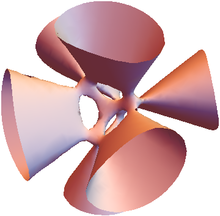
Dans la seconde partie de mon rapport, il s'agit des variétés kählériennes dites K3, ainsi nommées en l'honneur de Kummer, Kähler, Kodaira et de la belle montagne K2 au Cachemire.
In the second part of my report, we deal with the Kähler varieties known as K3, named in honor of Kummer, Kähler, Kodaira and of the beautiful mountain K2 in Kashmir.
André Weil (1958, p. 546), describing the reason for the name "K3 surface"
In mathematics, a complex analytic K3 surface is a compact connected complex manifold of dimension 2 with а trivial canonical bundle and irregularity zero. An (algebraic) K3 surface over any field means a smooth proper geometrically connected algebraic surface that satisfies the same conditions. In the Enriques–Kodaira classification of surfaces, K3 surfaces form one of the four classes of minimal surfaces of Kodaira dimension zero. A simple example is the Fermat quartic surface
in complex projective 3-space.
Together with two-dimensional compact complex tori, K3 surfaces are the Calabi–Yau manifolds (and also the hyperkähler manifolds) of dimension two. As such, they are at the center of the classification of algebraic surfaces, between the positively curved del Pezzo surfaces (which are easy to classify) and the negatively curved surfaces of general type (which are essentially unclassifiable). K3 surfaces can be considered the simplest algebraic varieties whose structure does not reduce to curves or abelian varieties, and yet where a substantial understanding is possible. A complex K3 surface has real dimension 4, and it plays an important role in the study of smooth 4-manifolds. K3 surfaces have been applied to Kac–Moody algebras, mirror symmetry and string theory.
It can be useful to think of complex algebraic K3 surfaces as part of the broader family of complex analytic K3 surfaces. Many other types of algebraic varieties do not have such non-algebraic deformations.
